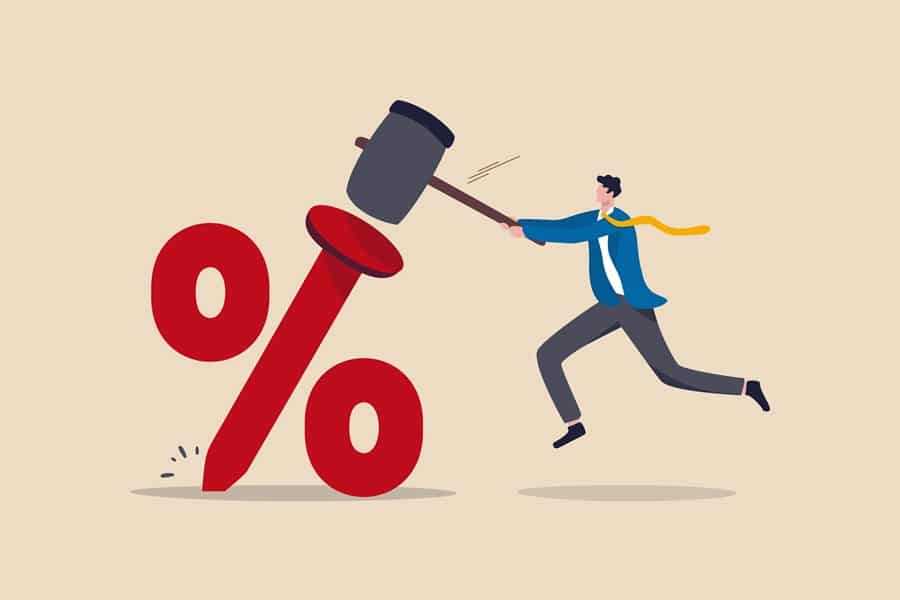Investing in Cryptocurrency in 2025: Complete Guide and Tips
2021 was an incredible year for investing in crypto and for cryptocurrency investors. We saw the total value in cryptocurrencies surpass the $2.5 trillion level in May 2021, and adoption rates for cryptocurrencies are skyrocketing, not just on Wall Street, but also among the average investor. Estimates are that roughly 14% of all American adults own some cryptocurrencies. That compares with about 55% of American adults who own stocks.
Fast forward to 2023 and, it has been, for the most part, a rough year not just for crypto, but nearly every asset class is feeling the pain from rising inflation and interest rates during a time that many feel is the beginning of a recession. Though just as bull runs don't last forever, neither do bear markets and many investors are seeing this as a prime opportunity to get in at "discount" prices.
Granted it’s a fairly large divide still between cryptocurrency owners and stock owners, but we also have to keep in mind that cryptocurrencies have been around for just a dozen years, while stocks have been around since 1611, or for more than 400 years. I think cryptocurrencies will catch up to stocks over the coming 400 years!
In terms of tradable opportunities, there are now more than 10,000 different cryptocurrencies according to Coinmarketcap.com. Some are huge, like Bitcoin, Ethereum, and Binance Coin, while others are so small that they have under $1 million in daily trading activity.
While some people are investing purely to speculate, others look at cryptos as a way to store value or hedge against inflation. The following guide will talk about how to invest in crypto in 2024, whether you should start investing, and what to know before you jump into this new opportunity.
Guy has put together this handy video on crypto investing on a budget if you are looking to get started with fewer funds.
Investing in Crypto? Prepare for Volatility and Risk!
I think it’s pretty well known that cryptocurrency investing and volatility go hand in hand. While the larger coins like Bitcoin and Ethereum have calmed down to some extent, moves of 10% are still not unusual. However smaller tokens can move that much and more day after day, and those moves can come in either direction. That makes it crucial to learn as much as possible about any token and its underlying project before investing.

In fact, the more you understand, the better investing decisions and choices you’ll be able to make. For example, some investors approach Bitcoin in much the same way they approach gold. They see it as a store of value, and as a way to hedge against inflation. That’s why Bitcoin has picked up the names “digital gold” and “gold 2.0”
Ethereum is a different story, with investors attracted to the second-largest cryptocurrency based on its utility and use in smart contracts and decentralized finance.
Cryptocurrencies are considered an alternative asset, a group that also includes real estate and commodities, because they are a way to diversify out of traditional assets like stocks and bonds. While they are great at providing diversification cryptocurrencies also remain quite volatile, and can even be influenced by news items and comments from popular personalities.
The good news is that despite the volatility, over the long-term Bitcoin has an average annualized return that’s greater than 200%. So embracing volatility can lead to impressive gains.
We often get asked, "is it a good idea to invest in cryptocurrency?" While that answer is different for everyone, hopefully, this article will help set you on the right path once you've decided to take the plunge into the wonderful world of crypto investing.
How to Invest in Cryptocurrencies in 2025
Cryptocurrency investing saw increased adoption in 2021; however, it remains an option that’s not available from traditional stock brokers – yet. Until it is investors need to become familiar with the various types of cryptocurrency brokers and exchanges that can help them get started in this new asset class. Those include centralized brokers like Coinbase, centralized exchanges like Binance and FTX, and decentralized exchanges like Uniswap.

In addition to the buying and selling of cryptocurrencies, there are other ways to invest too, and that means getting to know about staking, yield farming, crypto lending platforms, and even non-fungible token platforms.
Staking
Cryptocurrency staking is the processes of locking coins in a wallet and receiving rewards in return. These can be thought of as equivalent to the dividends you might earn from holding certain stocks. Whereas the stock dividends come from company earnings, the staking rewards from cryptocurrencies come from the transaction fees generated by the network, or from a pool that was created to provide staking rewards.

Staking also provides value to the blockchain by securing the network against attacks, and as a way to verify transactions.
As a crypto investor staking provides you with the means to generate passive income from your crypto portfolio. And the more cryptocurrency you hold, the greater your staking rewards become. It’s a great way to supplement your investing capital.
Popular Staking Coins in 2025
As you already know there are many different cryptocurrencies, and there are also many different cryptocurrencies that can be staked to earn yield. While the list below is far from exhaustive, it will give you a starting point in your research for good staking coins in 2025:
Cardano (ADA) – Cardano was created by one of the founders of Ethereum who was frustrated at the slow pace of development of Ethereum back in 2016. Cardano is also unique in that all its technology goes through a peer review process prior to being implemented.

Ethereum 2.0 (ETH) – Ethereum staking is a bit tricky at the moment as the merge was successful, yet the 32 ETH needed for individual stakers is still locked. Some centralized exchanges are offering Ethereum staking for users with under 32 ETH, but keep an eye out for Ethereum staking developments throughout 2024.
Polkadot (DOT) – Polkadot facilitates the cross-chain transfer of any data or asset types, not only cryptocurrencies. This achieves blockchain interoperability, which many believe will be one of the keys to blockchain adoption in the future.
Binance Coin (BNB) – This coin was created as a dedicated utility token for the Binance exchange and ecosystem. Since then it has caught the attention of speculators, making it the fourth-largest cryptocurrency.
Other popular coins that can be staked are Cosmos (ATOM), Solana (SOL), Tezos (XTZ) and more.
If you want to learn more about staking, be sure to check out our article on the Top Staking Coins.
Where to Stake Crypto
There are a number of ways and methods to stake cryptocurrencies. Some require you to hold them in a specific wallet, while others have minimum staking requirements that make it more feasible for most users to delegate their tokens to an actual node operator. And many are now supported by the various centralized cryptocurrency exchanges, with yield being paid out simply by holding the tokens in an exchange wallet.
In addition, there are new services that have been created specifically to allow users to deposit and stake. These services specialize in staking rather than exchanging or brokering. They include Staked and Stake Capital.
It’s worth noting that you’re going to find different terms, requirements, fees, and rules at the different staking platforms. It’s worth your time to examine these at the various places where staking is supported to be sure you’re getting the best deal, and that your goals align with the offerings of the service.
Liquid Staking
Staking algorithms typically require a validator to lock hefty sums of money in the protocol to participate in staking. Numerous decentralized liquid staking platforms have emerged today that break these barriers. In liquid staking (LSDfi), users delegate their funds to a pool that stakes on their behalf. Liquid staking platforms have very low entry requirements (some Liquid staking platforms let you participate in staking with as low as 0.001 ETH). The pool distributes the rewards to its contributors proportionately. Learn more about different staking alternatives in Coin Bureaue's learner on crypto staking.
Liquid Restaking
Liquid restaking is a practice where users deposit their Liquid Staking Tokens (LSTs) to a restaking middle layer protocol, that exposes the LSTs to secure new blockchain networks. Restaking leads to efficient resource utilization where the same cryptocurrency is exposed to slashing conditions from multiple networks (Ethereum and additional networks), allowing the new layer 1 network to commence operation without bootstrapping new liquidity. Liquid restaking lets users earn additional rewards for the extra risk assumed by them. There is a dedicated comprehensive explainer on Ethereum restaking, check that out for additional information.
Crypto Lending for Yield
Do you know where to find the best cryptocurrency interest rates?
As DeFi and CeFi applications continue growing and expanding, adding lending services, staking services, margin exchanges and more over the past few years it is becoming increasingly difficult to determine where investors can find the best yields for their idle capital. Answering the question of which platform has the best yields and interest rates is difficult as the rates are a moving target. Instead, it’s best to look at each and see how an investor might benefit from adding that service of protocol to their portfolio.
DeFi Lending
DeFi lending was created as a way to provide margin to traders on decentralized exchanges and as a way to borrow through DeFi applications. However, it’s important to understand that the supply and demand from these applications make yields for DeFi lending fairly volatile. In addition, because the majority of applications run on the Ethereum network the majority of borrowing and lending is with Ethereum, ERC-20 tokens, or wrapped tokens.
Popular DeFi lending platforms include:
Compound - A DeFi platform for tokenized lending and collateralized borrowing.
Cream - lending platform based on Compound Finance.
dYdX - A DeFi platform for collateralized borrowing, lending, and margin trading.
AAVE - Aave is a DeFi platform for collateralized borrowing and lending.
Centralized Lending
While decentralized lending has taken the spotlight recently, there are also a good number of centralized crypto lending platforms that investors can access. While you give up decentralization with these platforms, you typically gain more stable interest rates since the lender is setting the rates rather than relying on pure market forces. Investors will also find that interest rates on centralized platforms are typically higher than those on decentralized platforms. Here is an article covering the Top Lending Platforms for you to check out.
Yield Optimization Platforms
If searching through the lending platforms to find the best yield seems like a thankless task to you, then why not give it up and let a yield optimization platform handle the heavy lifting? Thanks to the innovations brought about by Yearn.Finance investors are now able to set it and forget it when it comes to finding yield.
That’s because these “programmable money” platforms use the tools available from the Ethereum network to locate the optimal interest rates at all times. With a yield optimization platform, investors are freed from the drudgery of constantly watching yields and moving their assets.
Yield optimization works by creating a pool for each asset that’s deposited. When a user makes a deposit to one of these pools they receive yTokens, which are simply a yield-bearing equivalent of the coin they deposited to the pool. As an example, if a user deposits CURVE into the protocol they receive an equal amount of yCURVE in return.
The assets held in the protocol are automatically shuffled to the highest yield-bearing lending platform in the entire DeFi ecosystem, thus maximizing yield at all times. The protocol checks for better yield-bearing opportunities every time a user makes a deposit into the protocol, and will rebalance the entire pool if necessary. Users can burn their yTokens at any time to receive their initial deposit and any accrued interest.
Investing Principles to Keep in Mind
The principles below might not seem new to experienced investors, but they are just as relevant in cryptocurrency investing in 2024 as they are for any other investment classes. If you take nothing else away from this article at least try to remember these things:
Never Invest What You Can’t Afford to Lose
When you first start investing it can be very exciting, and even addictive for some. This can be especially true if your first purchases occur during a bull run, when everything is heading massively higher. You might think things will be like that always, and that can lead to over-committing yourself and your capital.
Experienced investors know that there is always an element of risk in any investment. While some do have lower risks, the cryptocurrency class has some of the highest risks you’ll find. That means cryptocurrency investing should be approached carefully. Start with small amounts and grow your account slowly. And most importantly don’t use money you need for rent, food, or other necessities.

For some reason, some feel like they need to purchase 1 BTC or 1 ETH. This simply isn’t true. You can get started with cryptocurrency investing using as little as $10. Brokers and exchanges will let you purchase just 1 satoshi, which is the smallest fraction of Bitcoin and is equal to just one hundred millionth of a single bitcoin (0.00000001 BTC).
Starting small and slowly building up your crypto portfolio over time is the prudent course.
Invest in Alignment With Your Interests and Values
There are many ways to invest, from stocks to real estate and of course cryptocurrencies. Some people would never consider investing in real estate, others try to avoid investing in certain classes of stocks, such as energy or tobacco companies. Still, others will likely want to avoid cryptocurrencies, no matter how large the market grows.
Everyone should only invest in those assets that align well with their own values, beliefs, and interests. If you believe cryptocurrencies are the future of money, or that blockchain is the future of many types of technologies, then cryptocurrencies are an ideal investment opportunity. However, if you question the value and utility of cryptocurrencies and blockchain technology then it might be best to avoid the asset class altogether and focus on investments that are better aligned with your own ideals.
Follow a Core-Satellite Strategy
Diversification is a key to investing, but to meet your investing goals you should have a focus on your portfolio. This is accomplished by using a core investment and a group of smaller satellite investments. Your cryptocurrency investments will likely be a satellite to your overall investing strategy, but within that you can also have a core to your crypto investments, surrounded by satellite tokens or coins. The majority of your capital is allocated to the core.

For your crypto portfolio, you will want to choose one of the top ten cryptocurrencies as the core. These are proven, and while still volatile they will be more stable than new projects. You might choose Bitcoin, Ethereum, or something like Ripple as your core. Your satellites will be smaller projects or those cryptocurrencies you aren’t as confident in quite yet. Think of the satellites as more speculative investments.
It’s key that you identify your core and your satellites, and don’t confuse the two. Once you’re comfortable that you understand these three principles of investing in cryptocurrencies you’ll be able to choose the cryptocurrencies you want to invest in with confidence.
Maintain a Healthy Crypto Portfolio
Keeping a healthy portfolio means creating your core investment, and making sure you diversify by adding in a number of satellite investments. This helps to even out your returns as the winning picks offset any losing picks.
This is true of diversifying your entire portfolio by including cryptocurrencies and it's true of the crypto portion too. By adding a number of different cryptocurrencies you’re diversifying your risks and spreading your exposure to a broader mix of assets.
While this type of diversification means you’ll almost surely have some losers in your portfolio it’s far better to lose a few while winning some rather than losing it all because you kept all your crypto investment in one coin. You might not get the eye-watering returns of a single rocketing coin, but you also won’t risk losing everything if the coin you pick crashes and burns.
As 2023 was off to a rough start for the cryptocurrency markets, many were left wondering if we were in the midst of a bear market. As things are looking quite bearish you may be wondering what the best cryptocurrency to invest in a bear market is. We were wondering the same which is why we wrote this article about The Best Cryptocurrency to Invest in to Survive a Bear Market.
Don’t Make Investments on Hype
It’s true for stocks and even more true for crypto. Ignoring hype around a project or coin is going to be crucial to your success.

When cryptocurrencies are involved you should never base your investing on what others are saying (that’s true for any investment). Instead you should be studying the market, the project, and the price action of the coin and then taking all that knowledge and using it to make informed investing decisions. You still might take some risks, but at least they will be well-informed and calculated risks.
Basing your research on the advice of others can be acceptable, but you will need to learn how to distinguish between those with good knowledge of trading and investing and those who are simply trying to shill for a coin. Mastering this will allow you to filter out much of the noise in the crypto markets and focus on important information that lets you develop your own strategy. Coin Bureau refreshes its library with new guides, analysis, and reviews regularly. Exploring our content to stay on top of what happening in the cryptosphere. For instance, here is a comprehensive breakdown of everything in development in the Ethereum protocol.
Bitcoin Remained Dominant in 2023
Historically, the largest cryptocurrency by market cap has been Bitcoin, and that continued to be the case in 2023. That’s why it is the most talked about cryptocurrency, and the cryptocurrency that attracts the most investment capital. Bitcoin dominance in January 2023 was over 40% of the total market. In second place is Ethereum, which has a market domination of just over 18%. Then there are others such as Binance Coin, Ripple, and Cardano.

Given its dominant position and longevity, Bitcoin is currently the most reliable cryptocurrency for creating a core position. That said, Ethereum has performed better in 2021, albeit with more volatility as well. And some smaller cryptocurrencies have done even better. That’s why we recommend a diversified crypto portfolio.
Either Bitcoin or Ethereum would work well as a core, with smaller cryptocurrencies making up the satellite positions in your portfolio.
Keep in mind too that the broader market often takes its lead from Bitcoin. So when Bitcoin is rising the rest of the market also tends to do well. And when Bitcoin is falling the rest of the market tends to follow it lower. Consider Bitcoin as the core and all other cryptocurrencies as more speculative in nature and you will have a good start to a cryptocurrency portfolio in 2024.
These facts and tendencies should not be underestimated. Also, note that many of the cryptocurrencies introduced since 2009 have disappeared. That means any smaller project you invest in could disappear, leaving you with nothing. And that could happen very quickly, due to the inherent volatility of cryptocurrencies.
Next Steps in 2025
Once you know how you want to build your portfolio (which coins and the amounts), it’s time to find a suitable cryptocurrency exchange.

There are quite a few, and you’ll also want to decide if you’re going to use a broker (Coinbase is the largest) or a true exchange (Binance is the largest here). The benefit of the larger brokers and exchanges is that they have more coins listed to choose from, plus they are more liquid and more stable. These larger brokers and exchanges will also support staking, which allows you to generate passive income from your cryptocurrency holdings.
After you’ve made your choice of broker or exchange the next step is to create an account, complete the identity verification requirements (if necessary), and fund the account with some fiat currency. Remember that it isn’t necessary to buy an entire coin! If you only have $100 you can buy just that amount. Do watch out for the transaction fees however as they have become quite high in 2021 for many cryptocurrencies, including Bitcoin and Ethereum.
If you are looking for more resources on how to buy cryptocurrency, be sure to check out Guy's video on How to buy cryptocurrency safely
HODL in 2025
HODL is a term used in cryptocurrency that is an acronym for “Hold on for Dear Life”. It came about in the early days of cryptocurrency, when someone in a forum misspelt “hold” and has caught on as a defining term for the cryptocurrency markets.

Learning patience and the power of hodling in 2025 can be key to your investing strategy. Prices can move 20% or more in a single day and in either direction. Prices could drop for an extended period. For example, Bitcoin hit a high of nearly $20,000 in December 2017, but a year later was trading under $3,500. Many people lost a lot of money by selling during this time, and it was needless because in April 2021 Bitcoin hit a new all-time high of nearly $65,000. Hodling could have saved them from losses and given them a massive profit instead.
Consider too those who might have bought Bitcoin early in 2020 when it was trading at around $9,000. Because of the COVID-19 pandemic, the price lost nearly 50% by March 2020; however, as we know 2021 saw a massive rally in Bitcoin that saw prices go from the $5,000 level in March 2020 to almost $69,000 slightly over a year later. An investor might have sold at $10,000 or even $20,000 for an impressive gain, but it would have been peanuts compared to what they could have made.
As 2022-2023 has been a particularly rough time for cryptocurrency investors, while majors like Bitcoin and Ethereum are the “safe havens” many investors are sticking with, we have put together this guide on the Top Defensive Crypto Picks.
Beyond Buying Bitcoin in 2025
Buying and hodling Bitcoin (or Ethereum) will very likely be the core of your cryptocurrency investments, but as mentioned already you should also consider adding some smaller satellite positions. One way to supercharge your returns even more is to choose some of the staking coins as part of your holdings.
If you are looking for some tips or advice on what crypto to buy, or how to build your portfolio, we happen to cover that in our How to Build a Crypto Portfolio article, and Guy helps you discover what crypto to buy in his video on How to Find Altcoin Gems.
Bitcoin Market Trends Emerging in 2025:
- Bitcoin Exchange Liquidity at an All-time Low: The current all-time low in Bitcoin exchange liquidity can be interpreted as a bullish sign for the market. Lower exchange liquidity means there are fewer Bitcoins available for trading, which can lead to increased volatility and potential price increases if demand outpaces the available supply. This scarcity effect, combined with increased investor interest, could further fuel price appreciation.
- Smashing Success of Bitcoin ETFs: The launch of Bitcoin ETFs has been met with considerable success, attracting billions of dollars in investments. This influx of institutional and retail investment has provided a significant boost to the Bitcoin market, absorbing potential sell pressure and contributing to a more stable and maturing market ecosystem. ETFs have made Bitcoin more accessible to a broader audience of investors, financial advisors, and capital market allocators, potentially leading to increased mainstream adoption and further price increases post-halving.
Cryptocurrency Investing: Conclusion
When it comes to crypto investments, education is the key.
Understanding the basics of cryptocurrencies and crypto investing will help you make better sense of the crypto conversations that seem to be everywhere in 2024.
As an investor, even if you’re against cryptocurrencies, it is vitally important to understand them and to keep up with news and developments in the space. This will allow you to remain informed, and to modify your investing decisions if need be. It will also give you the ability to explain cryptocurrencies to friends and family who might be considering investing.
Ultimately it will be basic financial education that will help you decipher the latest positive trends from dangerous pump-and-dump schemes. Making cryptocurrencies a part of your investing strategy can help you to maximize your returns over time.
Disclaimer: These are the writer's opinions and should not be considered investment advice. Readers should do their own research.
Frequently Asked Questions
Investing in cryptocurrency carries risks such as high price volatility, regulatory uncertainty, and security vulnerabilities. It's important to be aware of these risks and carefully consider them before investing.
Choosing a cryptocurrency to invest in involves conducting thorough research on factors such as the project's technology, team, market adoption, and potential for long-term growth. Additionally, assessing market trends and expert opinions can help inform investment decisions.
One example of a popular method that crypto investors use to build their portfolio is by using Modern Portfolio Theory, and we have a guide on How to Build a Crypto Portfolio to help new investors.
Investing in cryptocurrency can be done through various methods, including buying and holding (HODLing) popular cryptocurrencies, participating in initial coin offerings (ICOs), engaging in cryptocurrency trading on exchanges, or investing in cryptocurrency funds. Just be sure to use a reputable crypto exchange and learn about self-custody!
Securing cryptocurrency investments involves using reputable wallets (hardware, software, or paper wallets) to store digital assets, enabling two-factor authentication (2FA) for exchange and wallet accounts, and practicing good cybersecurity measures such as avoiding suspicious links or phishing attempts.
Be sure to check out our comprehensive article on Crypto Safety.
Yes, it is possible to invest in cryptocurrency with a small budget. Many cryptocurrencies have divisible units, allowing investors to purchase fractions of a token. Additionally, some exchanges offer the option to invest in cryptocurrency with minimal amounts. Many people don't realize that you do not need to purchase an entire coin, like Bitcoin. Investors can purchase fractions of Bitcoin, known as Satoshis, similar to how cents make up a dollar.
Reliable information about investing in cryptocurrency can be found through reputable cryptocurrency news websites, forums, and educational resources provided by established exchanges and industry experts. It's important to cross-reference information and consider multiple sources before making investment decisions.
To help, we have compiled a list of the Top Crypto YouTubers, Top Crypto Podcasts, and Top Crypto Telegram Channels to check out.
Disclaimer: These are the writer’s opinions and should not be considered investment advice. Readers should do their own research.

